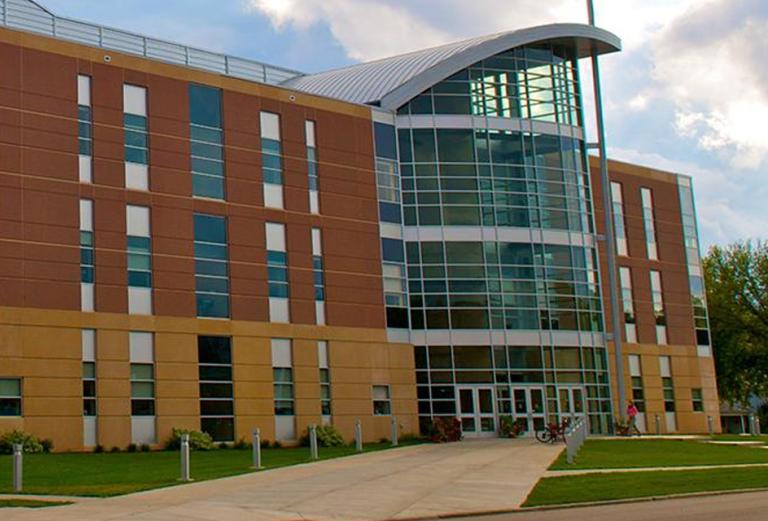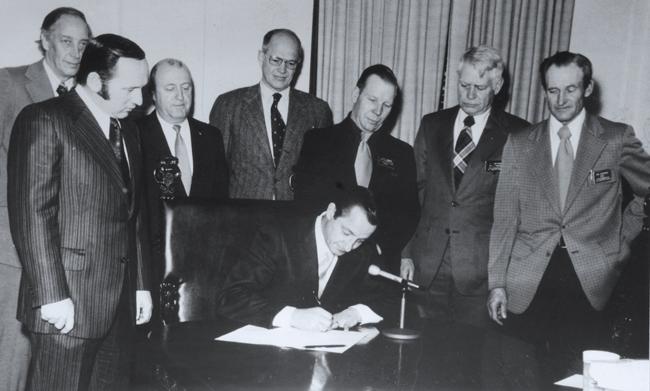Stately Renovation
A life built on public service transformed a state’s health care system
- Profile

The Sanford School of Medicine in South Dakota, which began as a two-year school, has become a vibrant center for medical care and education
To his friends and colleagues, Karl Wegner ’58 was a man of resolute purpose. He wanted to make a difference, and he did so by changing and improving health care and medical education in South Dakota.
That drive to make a difference was cultivated from an early age. When just a boy, Wegner would enjoy summers at his grandparents’ cabin in the Black Hills of South Dakota. There, he would spend time with his grandfather, Peter Norbeck. Norbeck was a larger-than-life figure—successful businessman, governor, state senator, and three-term U.S. senator—a man with a mind to improve South Dakota and a dream of preserving the state’s and the nation’s natural beauty. He accomplished both. Norbeck’s work helped create Custer State Park in South Dakota and the Wind Cave and the Badlands national parks. Another dream, to transform the open granite faces in the Black Hills into a monument, led to Mount Rushmore.
Norbeck left these considerable legacies to Wegner and to the people of the nation. It’s not surprising, then, that when it came to ideas, his grandson thought big. Wegner was determined to improve health care for the people of South Dakota and, in doing so, achieved what he considered to be his greatest accomplishment: transforming a two-year medical school into a degree-granting four-year institution known today as the University of South Dakota Sanford School of Medicine. Located in Sioux Falls and Vermillion, the school emphasizes primary care and family medicine.
Base of Operations
During his undergraduate years at Yale University, Wegner had focused on engineering but had also gathered credits valid toward a medical school application. Following graduation, he enlisted in the U.S. Marine Corps and was about to join the conflict in Korea when command officers decided his engineering skills would be better used stateside.
By the time he received his discharge, Wegner had decided to attend medical school. In an odd twist of fate, he was denied acceptance into South Dakota’s two-year institution; HMS thought otherwise, however, and accepted him. He began his studies in September 1954. During his first year, Wegner developed strong friendships with his dissecting mates in anatomy, Angelo Eraklis ’58, Sergei Sorokin ’58, and Kirby von Kessler ’58. Coincidentally, von Kessler also had a connection to South Dakota. He had spent his early years around Fort Meade, the Army base where his father, Major Wilson C. von Kessler, was commander and a surgeon.
In 1962, following a pathology residency at Massachusetts General Hospital, Wegner listened to his heart and returned to South Dakota, accepting a position as chief of pathology at Sioux Valley Hospital in Sioux Falls, then a city of more than 65,000 people. He also began teaching pathology to second-year medical students at the University of South Dakota’s two-year medical school. In a few years, this one teaching opportunity put Wegner, and South Dakota’s two-year medical school, on a path toward change.
Our Man in Sioux Falls
Wegner’s skills as a teacher and as a pathologist were well recognized. So too was his passion for improving opportunities for a medical education in South Dakota. He was encouraged to become dean of the medical school and accepted on the condition that he be allowed to develop the school into a four-year institution with degree-granting authority. It was a change that was sorely needed. Not only had it become increasingly difficult to place second-year medical students in third-year classes at other schools around the country, but those students often took their residency training where they earned their medical degree. Most never returned to South Dakota. This migration was taking a toll. In the early 1970s, South Dakota had a low, arguably the lowest, physician to population ratio in the United States.
Despite what these facts meant for the quality of health care for state residents, the frugal members of the South Dakota legislature, as well as many physicians in the state, remained unconvinced of the need for change. Many practitioners feared competition and thought it unnecessary to increase the state’s number of doctors. They also argued that the state’s small population would provide an inadequate training ground for medical students, that they would not gain experience treating a wide variety of disease states.
Wegner focused his efforts on the state’s legislators, believing that the physicians would recognize the benefit over time.
“He had to convince a conservative legislature,” says Lawrence Piersol, judge of the U.S. District Court for the District of South Dakota and former majority leader of the South Dakota House of Representatives. “He knew South Dakota, and he understood those legislators. I think he saw every one of them and talked to every one of them. And he convinced them.”
Adds Piersol, “When I was majority leader, Karl was the person who more than anybody, in my opinion, was responsible for making me and my colleagues believe that we could go from the two-year medical school we had to a four-year medical school. And that it would work. I mean, he worked on that issue without fatigue, and his arguments were credible.”
Wegner’s education at Yale and Harvard contributed to that credibility, as did having a grandfather important to South Dakota. But serendipity may have occasionally played a role. During a conversation with Kirby von Kessler, Wegner recalled talking with a state senator about his experience in medical school and mentioned that the father of one of his classmates was Major von Kessler of Fort Meade. Kirby von Kessler remembers Wegner saying, “The senator was surprised and said, ‘Von Kessler? When I was a child, Major von Kessler took out my appendix and saved my life. He was the only physician for miles around. He charged my parents only $25.’
“Then he asked, ‘How much money would you need for that school?’ ”
Party Politics
There were others who needed to be won over, however. Wegner traveled, calling on people at their homes and places of work. He and his wife, Mary Jo, hosted dinner parties at which he presented his case for the school. During these get-togethers, Wegner would offer novel approaches to overcoming some of the concerns their guests expressed. He countered worries over the cost of construction, for example, by proposing what he called a “medical school without walls” that would use existing health care facilities in Sioux Falls and Yankton, South Dakota, for teaching the final two clinical years.

His efforts were met with success. In 1974, authority was granted by the state legislature with the senate voting 35 to 0 and the house 54 to 14 to establish a four-year degree-granting medical school. Then-governor Richard Kneip also strongly endorsed the change.
“It was really Karl’s work—traveling all over the state, talking to everybody—that I think led the legislature to decide to fund a four-year program rather than to close the school,” says Robert Talley, former dean of the University of South Dakota Sanford School of Medicine, now with the Sioux Falls VA Health Center. “I really think he carried the day, because when you talked to individuals, they all thought the school would close, and not because South Dakota didn’t have the money. Most thought the state wasn’t capable of having a medical school. Karl convinced them otherwise.”
Family Affair
With the first third-year class entering in 1975 and a four-year curriculum to implement, the new school needed new faculty. Again, Wegner and his wife opened their home to candidates. Their children, Madeleine (Maddy), Mary Nell, and Peter, who had previously distributed bumper stickers promoting the idea of the four-year school, and had even stuck them on their desks at school, were again enlisted, this time to meet with the children of the candidates and to tell them how good it was to live in South Dakota. Taken together, his tactics worked; Wegner assembled a top-flight faculty. Students, too, came to the school, not only from South Dakota but from nearby states as well.
“He changed South Dakota medicine overnight,” says John Barlow ’58, a retired pathologist who was a friend and colleague of Wegner’s. “It just changed. People started to come here.”
Transformation
Wegner retired as dean in 1980 and was soon invited to join the Board of Regents, which had responsibility for all colleges and universities in the state. He ultimately became the board’s chairman and used his time in the position to promote the development and implementation of quality programming for the students of South Dakota.
The new four-year medical school produced profound changes in Sioux Falls and the state. In the 1960s, Sioux Valley Hospital had 300 beds, as did McKennan Hospital; the Veterans Hospital had 150. Today, there are about 1,200 beds in Sioux Falls’ hospitals, and health care has become a significant contributor to the state’s economy. The Sanford School of Medicine health care system now serves people living within 200,000 square miles.
Today, South Dakota’s medical school stands as witness to Wegner’s vision of a competitive, rigorous medical education that would build a corps of homegrown physicians for the state. As noted in the school’s mission statement: “The curriculum is to be established to encourage graduates to serve people living in the medically underserved areas of South Dakota.” In 2014, 53 new physicians, many of them from South Dakota, received their degrees; more than 600 graduates currently serve the state’s population. Outside of education, the medical school has stimulated growth of the biotech and biomedical industries in South Dakota, growth of the state as a regional health care center, and growth of biomedical research in the state.
This past year, Wegner died of complications from a fall. He is, however, remembered well by his classmates. Howard Corwin ’58, notes, “In many ways our past and present graduating doctors are the Renaissance men and women of our day, broad in the arts and the sciences, qualified to create and fulfill missions that will benefit humanity. Karl Wegner was one such person. He fulfilled the highest ideals of our noble profession.”
Elliott Miller ’58 has retired from practice and now lives in Maine. Like Karl Wegner, he is a native son of South Dakota.
Images: Courtesy of the University of South Dakota Sanford School of Medicine